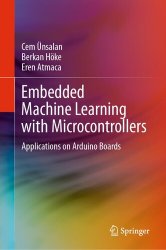Embedded Machine Learning with Microcontrollers: Applications on Arduino Boards
- Добавил: literator
- Дата: 4-06-2025, 21:34
- Комментариев: 0
 Название: Embedded Machine Learning with Microcontrollers: Applications on Arduino Boards
Название: Embedded Machine Learning with Microcontrollers: Applications on Arduino BoardsАвтор: Cem Ünsalan, Berkan Höke, Eren Atmaca
Издательство: Springer
Год: 2025
Страниц: 372
Язык: английский
Формат: pdf (true), epub
Размер: 18.4 MB
This textbook introduces basic and advanced embedded Machine Learning methods by exploring practical applications on Arduino boards. By covering traditional and neural network-based Machine Learning methods implemented on microcontrollers, the text is designed for use in courses on microcontrollers and embedded Machine Learning systems. Following the learning-by-doing approach, the book will enable students to grasp embedded Machine Learning concepts through real-world examples, providing them with the design and implementation skills needed for a competitive job market. By utilizing a programming environment that enables students to reach and modify microcontroller properties easily, the material allows for fast implementation of the developed system. Students are guided in implementing Machine Learning methods to be deployed and tested on microcontrollers throughout the book, with the theory behind the implemented methods also emphasized. Sample codes and real-world projects are available for readers and instructors. The book will also be an ideal reference for practicing engineers and electronics hobbyists.
This book introduces Machine Learning concepts on microcontrollers. While doing so, we aim to form a complete structure. Therefore, we will introduce the hardware and software to be used in the book in Chaps. 2 and 3, respectively. To be more specific, we will introduce the Nano33 board and nRF microcontroller on it in Chap. 2. Then, we will explore the Arduino IDE as the software platform to program the microcontroller in Chap. 3. Next, we will cover data acquisition methods from sensors in Chap. 4. We will cover the temperature and humidity sensor to acquire relative humidity and temperature data. We will benefit from the accelerometer, gyroscope, and magnetometer sensor to acquire motion data. We will use a digital microphone to acquire audio data. Finally, we will benefit from a digital camera to acquire digital images. We will also transfer the acquired data to PC for further processing.
As we form the foundations on the microcontroller and sensors side, Chap. 5 introduces fundamental machine learning concepts to be used throughout the book. Hence, we will cover the definition of feature and related topics. We will introduce traditional machine learning methods from Chaps. 6 to 8 as classification, regression, and clustering, respectively. In all these chapters, we follow the same strategy such that we will first provide the theoretical background for the method to be implemented. Then, we will provide the method to train it. Afterward, we will explain how to implement and test the trained method on the microcontroller. We will provide real-life examples as the end of chapter applications.
We will start neural network-based methods by introducing the TensorFlow platform and Keras API in Chap. 9. These will be used extensively while handling neural networks on PC. Then, we will cover the fundamentals of neural networks in Chap. 10. In this chapter, we will explain important topics using a single neuron. The single neuron may not be sufficient to solve most real-life problems. Hence, we will introduce the multi-layer neural network concept in Chap. 11. We will emphasize training the neural network model on PC in these two chapters. We will next cover methods of embedding the trained neural network model to the microcontroller in Chap. 12. To do so, we will introduce methods based on TensorFlow Lite Micro. We will show how the multi-layer neural network can be used as a classifier and regressor as the end of chapter applications in Chaps. 10 to 12.
Convolutional neural networks (CNN) are extensively used in computer vision applications. Hence, we will introduce them in Chap. 13. As in previous chapters, we will explain how to train the CNN model on PC and make inference by it on the microcontroller. We will cover recurrence in neural networks by introducing recurrent neural networks (RNN), gated recurrent units (GRU), and long short-term memory (LSTM) in Chap. 14. We will also train these models on PC and make inference by them on the microcontroller. Finally, we will provide extra information on probability theory and advanced hardware properties of the Nano33 board in the Appendix.
Sample codes and libraries introduced in the book are available at Github. This GitHub repository also contains all Arduino projects for the sample codes and end of chapter applications in the book.
Скачать Embedded Machine Learning with Microcontrollers: Applications on Arduino Boards
[related-news] [/related-news]
Внимание
Уважаемый посетитель, Вы зашли на сайт как незарегистрированный пользователь.
Мы рекомендуем Вам зарегистрироваться либо войти на сайт под своим именем.
Уважаемый посетитель, Вы зашли на сайт как незарегистрированный пользователь.
Мы рекомендуем Вам зарегистрироваться либо войти на сайт под своим именем.
